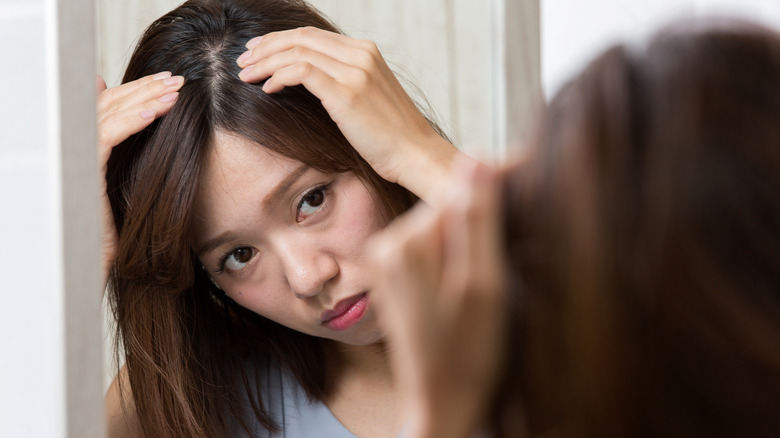This Is How To Avoid Getting Acne Along Your Hairline
Many of us have been trained to wash our faces without fail every morning and evening. Going through the motions, our fingers gently lather the product in circles as we hope it does it's job. However, this process can sometimes leave certain areas defenseless when we miss washing them. One of these places often comes along our hairlines. Particularly during the warmer seasons, hairline acne can become even more noticeable underneath the sweat, oil and makeup that can get stuck there.
"[It's] a unique part of the face because it can be in direct contact with your hair," dermatologist Tanya Kormeili, M.D., tells Mindbodygreen. "Any styling hair products such as oils or gels, etc., can accidentally be in contact with the forehead skin and lead to clogging of the pores and acne."
In addition to becoming a hotbed for various residues, these products mix with sweat to clog pores — leaving a strip of bumps. Furthermore, many people forget to properly cleanse this area after a long day. Certified trichologist, Shab Reslan, explains, "Most people experience them closer to the hairline for two reasons: Your face cream or makeup may not get washed off properly and still remain in your hairline. And the hairline is often neglected when shampooing, thus leaving natural hair oil on the scalp."
Since this area is somewhat difficult to reach, it makes sense that you may forget to properly wash it sometimes. As soon as you start noticing a row of white heads, it may be time to take a closer look.
There are two kinds of hairline breakouts
While you may think that blemishes in this area are just like the other ones you deal with on your face, hairline zits fall into two categories. Byrdie cites these two types as fungal acne and inflammatory papules. The latter is simply the type of breakouts that you would expect. "I find it is common to see inflammatory papules, which look like pink bumps or pimples," Naissan O. Wesley, M.D., F.A.C.M.S. CV, notes. "However, any type of acne can be found, including comedones, which is the medical term for blackheads and whiteheads, pustules, and cysts."
On the other hand, fungal acne stems from a build up of products and bacteria. "There is a condition called Pityrosporum Folliculitis that is caused by the fungus that causes dandruff. Overgrowth of this organism on the scalp can spill down onto the forehead/hairline, behind the ears, and back," Purvisha Patel, MD tells the outlet.
The first place to start is by checking your hair products for pore-clogging ingredients like oil. The outlet suggests steering clear of food ingredients as hair treatments, as these can exacerbate oily skin and leave you with blemishes. Furthermore, it may be a sign that you need to wash your hair more frequently. By keeping build-up to a minimum, you'll be better able to fight off painful bumps and avoid breakouts in the future.

